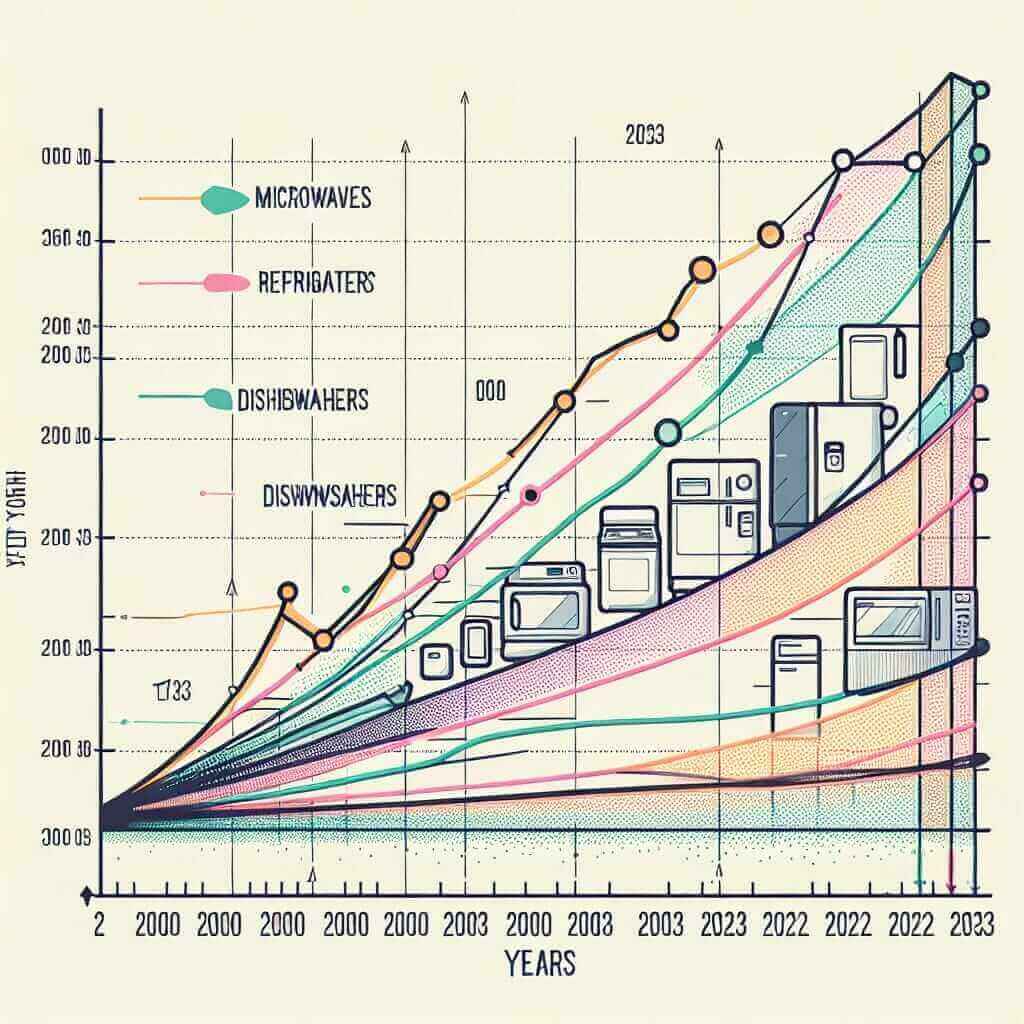The analysis of market trends, especially in specific sectors, has always been a prominent part of the IELTS Writing Task 1. Understanding and dissecting various types of data is crucial for candidates who aim to score high in this section. This article will explore the sales trends for different types of kitchen appliances from 2000 to 2023, a topic that aligns well with typical IELTS writing tasks. We will provide an in-depth sample task, a comprehensive model answer, and essential vocabulary and grammar recommendations for tackling such tasks effectively.
Understanding the Task
The topic of “Sales of Different Types of Kitchen Appliances (2000-2023)” involves interpreting visual data, such as line graphs, bar charts, pie charts, or tables. Candidates are required to identify and summarize key features and trends in the presented data.
For this exercise, we will create a sample task using a line graph that charts the sales of three different types of kitchen appliances: microwaves, refrigerators, and dishwashers over the period from 2000 to 2023.
Sample Task
Task: The line graph below shows the sales of different types of kitchen appliances (microwaves, refrigerators, and dishwashers) from 2000 to 2023.

Write a report for a university lecturer describing the information shown.
Analyzing the Task
Before writing the response, it’s essential to thoroughly analyze the given data:
- Introduction: Start by introducing the graph, stating what it shows, and the time frame.
- Overview: Identify the main trends and any significant data points. Discuss the general patterns observed.
- Details: Break down the trends into more specific details. Compare the sales of different appliances in various years.
Writing Sample
Introduction
The line graph displays the sales figures for three types of kitchen appliances, namely microwaves, refrigerators, and dishwashers, over a period from 2000 to 2023.
Overview
Overall, the sales of all three types of appliances have shown an upward trend over the given period. Microwaves have consistently had the highest sales, whereas dishwashers had the lowest sales initially but showed a significant increase towards the end of the period.
Detailed Analysis
In 2000, the sales of microwaves were around 90,000 units, which were the highest among the three appliances. The sales of refrigerators and dishwashers were 60,000 and 20,000 units, respectively. Over the next five years, the sales of microwaves increased steadily, reaching a peak of 150,000 units in 2005.
Refrigerators also saw a gradual increase in sales, peaking at 90,000 units in 2010. On the other hand, dishwasher sales showed a marginal rise to 30,000 units by 2005.
From 2005 to 2015, the growth trend continued for microwaves and refrigerators, though at a slower rate. By 2020, microwave sales stabilized at around 180,000 units, while refrigerator sales reached 120,000 units.
The most striking change was observed in dishwasher sales, which accelerated significantly from 2015 onwards, reaching 110,000 units by 2023, almost catching up with refrigerator sales. Meanwhile, the sales of microwaves and refrigerators remained relatively stable after 2020.
Word Count: 241 words
Key Considerations in Writing
- Tenses: Use the past simple to describe past data, and present perfect for current trends continuing from the past.
- Comparative Language: Phrases like “higher than,” “lower than,” “more significant increase,” etc.
- Transition Words: Phrases such as “overall,” “on the other hand,” “by contrast,” “meanwhile,” etc., to connect ideas and provide clear structure.
Important Vocabulary and Structures
- Upward Trend: A consistent increase in numbers (e.g., The sales of refrigerators have shown an upward trend over the years.)
- Peak: The highest point in data (e.g., Microwave sales peaked at 150,000 units in 2005.)
- Stabilize: When data levels off after fluctuating (e.g., The sales of microwaves stabilized at around 180,000 units by 2020.)
- Accelerate: To grow at a faster rate (e.g., Dishwasher sales accelerated significantly from 2015 onwards.)
- To Outpace: To grow faster than something else (e.g., Dishwashers sales outpaced those of refrigerators from 2015 onwards.)
Sample Vocabulary
- Consistently: Steadily during a period
- Marginal: Minor and insignificant
- Significant: Noteworthy or important
- Accelerate: Increase in rate
- Stabilize: Maintain at a steady level
Conclusion
In essence, the ability to analyze and report data is a crucial skill in the IELTS Writing Task 1. By understanding the trends, using comparative language effectively, and employing a range of transition phrases, candidates can create coherent and comprehensive reports. Remember, practice and familiarity with different types of diagrams and trends are key to attaining a high band score in such tasks.